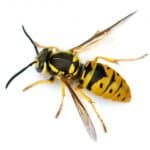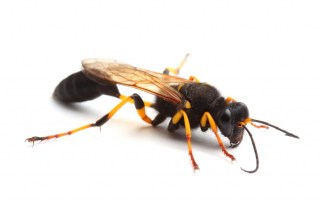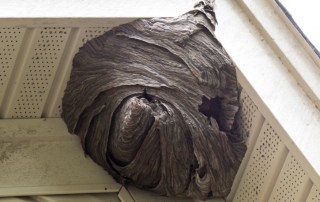In Canada, there are more than fifteen species of social wasps that are black as well as yellow, white or brown. They are less hairy than bumblebees and honeybees, their hair is not branched, and they do not have baskets on their legs to collect pollen. There are also several species of solitary wasps that have various shades (blue, black, red, etc.)
Latin Name: Vespa
Description:In Canada, there are more than fifteen species of social wasps that sport black as well as yellow, white or brown.They are less hairy than bumblebees and honeybees, their hairs are not branched, and they do not wear baskets on their legs to collect pollen. There are also several species of solitary wasps that have various colors (blue, black, red, etc.).It has two pairs of wings, one smaller than the otherThree pairs of legs that really have no specialtyHis abdomen ends in the queen with the egg-laying organ and in the workers with the sting.The male does not sting. Its society consists of the queen, much larger, the workers and the males.
Reproduction: The queen fertilized in the fall spends the winter in a shelter that she leaves in the spring to found a colony called a swarm.She will choose a place near a tree whose wood chewed and soaked with saliva will serve to build his nest. Other species will build a nest with mud, dig a gallery in the ground or lay eggs directly on a prey (parasites). Then the queen makes a few cells to lay her eggs which will hatch after a few days. The wasp raises the first workers alone until the first workers take over after about 20 days. The wasp’s nest expands throughout the summer. Towards the end of the summer the workers enlarge the size of the cells to accommodate the unborn males. The workers must feed the males and future queens, they do not do this themselves. Mating takes place in late summer and only a certain number of queens will survive the winter. The old queen, workers and males die in the fall.
Habits: Like the bee, the wasp participates in the pollination of flowers. Each wasp’s nest is a small architectural masterpiece, and despite their apparent fragility, it is fascinating to observe the precision and ingenuity of the construction. The colors of the nest vary according to the type of wood, leaves and flowers used, so each species of wasp has specific materials and the construction of the nest varies from one swarm to another. For example, the nest of the black wasp, or cardboard wasp, is made primarily of paper, while the yellow wasp uses tiny pressed wood chips that provide a light brown and sometimes delicate beige habitat. Some species commonly nest under the eaves, while others prefer the outer edge of windows. Wasps can accidentally enter the house through a window or door that is ajar and never find their way out.If a queen enters the house, she may establish her nest in the attic.Sometimes, when they have taken advantage of an opening to establish their nest in a wall, the colony, as it expands, may become cramped. Wasps can then use their mouth parts as a tool to get into a house.They can also be seen around our food containing protein or sugar.




